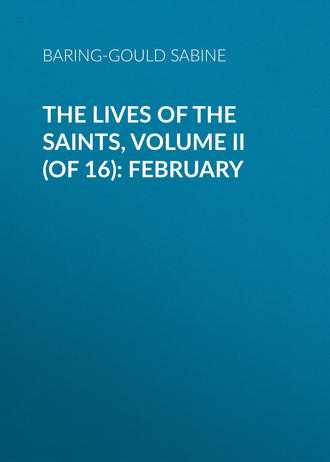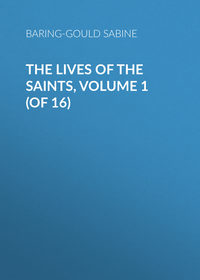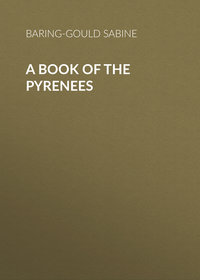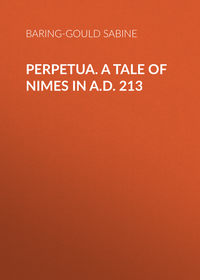 полная версия
полная версияThe Lives of the Saints, Volume II (of 16): February
Ireland was, of old, called the Isle of Saints, because of the great number of holy ones of both sexes who flourished there in former ages; or, who, coming thence, propagated the faith amongst other nations. Of this great number of saints the three most eminent, and who have therefore been honoured as the special patrons of the island, were S. Patrick their apostle, S. Columba, who converted the Picts, and S. Bridget, the virgin of Kildare, whose festival is marked in all the Martyrologies on the 1st day of February.
This holy virgin was born about the middle of the fifth century, in the village of Fochard, in the diocese of Armagh. Her father was a nobleman, called Dubtach, descended from Eschaid, the brother of King Constantine of the Hundred Battles, as he is surnamed by the Irish historians. The legend of her origin is as follows, but it is not to be relied upon, as it is not given by Ultan, Cogitosus, or Chilian of Inis-Keltra.6 Dubtach had a young and beautiful slave-girl, whom he dearly loved, and she became pregnant by him, whereat his wife, in great jealousy and rage, gave him no peace till he had sold her to a bard, but Dubtach, though he sold the slave-girl, stipulated with the purchaser that the child should not go with the mother, but should be returned to him when he claimed it.
Now one day, the king and queen visited the bard to ask an augury as to the child they expected shortly, and to be advised as to the place where the queen should be confined. Then the bard said, "Happy is the child that is born neither in the house nor out of the house!" Now it fell out that Brotseach, the slave-girl, was shortly after returning to the house with a pitcher of fresh warm milk from the cow, when she was seized with labour, and sank down on the threshold, and was delivered neither in the house nor out of the house, and the pitcher of warm sweet milk, falling, was poured over the little child.
When Bridget grew up, her father reclaimed her, and treated her with the same tenderness that he showed to his legitimate children. She had a most compassionate heart, and gave to every beggar what he asked, whether it were hers or not. This rather annoyed her father, who took her one day with him to the king's court, and leaving her outside, in the chariot, went within to the king, and asked his majesty to buy his daughter, as she was too expensive for him to keep, owing to her excessive charity. The king asked to see the girl, and they went together to the door. In the meantime, a beggar had approached Bridget, and unable to resist his importunities, she had given him the only thing she could find, her father's sword, which was a present that had been made him by the king. When Dubtach discovered this, he burst forth into angry abuse, and the king asked, "Why didst thou give away the royal sword, child?" "If beggars assailed me," answered Bridget calmly, "and asked for my king and my father, I would give them both away also." "Ah!" said the king, "I cannot buy a girl who holds us so cheap."
Her great beauty caused her to be sought in marriage by a young noble of the neighbourhood, but as she had already consecrated herself by vow to Jesus, the Spouse of virgins, she would not hear of this match. To rid herself of the importunity of her suitor, she prayed to God, that He would render her so deformed that no one might regard her. Her prayer was heard, and a distemper fell on one of her eyes, by which she lost that eye, and became so disagreeable to the sight, that no one thought of giving her any further molestation.7 Thus she easily gained her father's consent that she should consecrate her virginity to God, and become a nun. She took with her three other virgins of that country, and bidding farewell to her friends, went in 469 to the holy bishop Maccail, then at Usny hill, Westmeath; who gave the sacred veil to her and her companions, and received their profession of perpetual virginity. S. Bridget was then only fourteen years old, as some authors assert. The Almighty was pleased on this occasion to declare how acceptable this sacrifice was, by restoring to Bridget the use of her eye, and her former beauty, and, what is still more remarkable, and is particularly celebrated, as well in the Roman, as in other ancient Martyrologies, was, that when the holy virgin, bowing her head, kissed the dry wood of the feet of the altar, it immediately grew green, in token of her purity and sanctity. The story is told of her, that when she was a little child, playing at holy things, she got a smooth slab of stone which she tried to set up as a little altar; then a beautiful angel joined in her play, and made wooden legs to the altar, and bored four holes in the stone, into which the legs might be driven, so as to make it stand.
S. Bridget having consecrated herself to God, built a cell for her abode, under a goodly oak, thence called Kil-dare or the Cell of the Oak; and this foundation grew into a large community, for a great number of virgins resorted to her, attracted by her sanctity, and put themselves under her direction. And so great was the reputation of her virtues, and the place of her abode was so renowned and frequented on her account, that the many buildings erected in the neighbourhood during her lifetime formed a large town, which was soon made the seat of a bishop, and in process of time, the metropolitan see of the whole province.
What the rule embraced by S. Bridget was, is not known, but it appears from her history, that the habit which she received at her profession from S. Maccail was white. Afterwards, she herself gave a rule to her nuns; so that she is justly numbered among the founders of religious Orders. This rule was followed for a long time by the greatest part of the monasteries of sacred virgins in Ireland; all acknowledging our Saint as their mother and mistress, and the monastery of Kildare as the headquarters of their Order. Moreover, Cogitosus informs us, in his prologue to her life, that not only did she rule nuns, but also a large community of men, who lived in a separate monastery. This obliged the Saint to call to her aid out of his solitude, the holy bishop S. Conlaeth, to be the director and father to her monks; and at the same time to be the bishop of the city. The church of Kildare, to suit the requirements of the double monastery and the laity, was divided by partitions into three parts, Cogitosus says, one for the monks, one for the nuns, and the third for the lay people.
As S. Bridget was obliged to go long journeys, the bishop ordained her coachman priest, and the story is told that one day as she and a favourite nun sat in the chariot, the coachman preached to them the Word of God, turning his head over his shoulder. Then said the abbess, "Turn round, that we may hear better, and throw down the reins." So he cast the reins over the front of the chariot, and addressed his discourse to them with his back to the horses. Then one of the horses slipped its neck from the yoke, and ran free; and so engrossed were Bridget and her companion in the sermon of the priestly charioteer, that they did not observe that the horse was loose, and the carriage running all on one side. On another occasion she was being driven over a common near the Liffey, when they came to a long hedge, for a man had enclosed a portion of the common. Then the man shouted to them to go round, and Bridget bade her charioteer so do. But he, thinking that they had a right of way across the newly made field, drove straight at the hedge; then the proprietor of the field ran forward, and the horses started, and the jolt of the chariot threw S. Bridget and the coachman out of the vehicle, and severely bruised them both. Then the abbess, picking herself up said, "Better to have gone round; short cuts bring broken bones."
Once a family came to Kildare, leaving their house and cattle unguarded, that they might attend a festival in the church, and receive advice from S. Bridget. Whilst they were absent, some thieves stole their cows, and drove them away.
They had to pass the Liffey, which was much swollen, consequently the thieves stripped, and tied their clothes to the horns of the cattle, intending to drive the cows into the river, and swim after them. But the cows ran away, carrying off with them the clothes of the robbers attached to their horns, and they did not stop till they reached the gates of the convent of S. Bridget, the nude thieves racing after them. The holy abbess restored to them their garments, and severely reprimanded them for their attempted robbery.
Other strange miracles are attributed to her, of which it is impossible to relate a tithe. She is said, after a shower of rain, to have come hastily into a chamber, and cast her wet cloak over a sunbeam, mistaking it, in her hurry, for a beam of wood. And the cloak remained there, and the ray of sun did not move, till late at night one of her maidens ran to her, to tell her that the sunbeam waited its release, so she hasted, and removed her cloak, and the ray retired after the long departed sun.
Once a rustic, seeing a wolf run about in proximity to the palace, killed it; not knowing that it was the tame creature of the king; and he brought the dead beast to the king, expecting a reward. Then the prince in anger ordered the man to be cast into prison and executed. Now when Bridget heard this, her spirit was stirred within her, and mounting her chariot, she drove to the court, to intercede for the life of the poor countryman. And on the way, there came a wolf over the bog racing towards her, and it leaped into the chariot, and allowed her to caress it. Then, when she reached the palace, she went before the king, with the wolf at her side, and said, "Sire! I have brought thee a better wolf than that thou hast lost, spare therefore the life of the poor man who unwittingly slew thy beast." Then the king accepted her present with great joy, and ordered the prisoner to be released.
One evening she sat with sister Dara, a holy nun, who was blind, as the sun went down; and they talked of the love of Jesus Christ, and the joys of Paradise. Now their hearts were so full, that the night fled away whilst they spoke together, and neither knew that so many hours had sped. Then the sun came up from behind Wicklow mountains, and the pure white light made the face of earth bright and gay. Then Bridget sighed, when she saw how lovely were earth and sky, and knew that Dara's eyes were closed to all this beauty. So she bowed her head and prayed, and extended her hand and signed the dark orbs of the gentle sister. Then the darkness passed away from them, and Dara saw the golden ball in the east, and all the trees and flowers glittering with dew in the morning light. She looked a little while, and then, turning to the abbess, said, "Close my eyes again, dear mother, for when the world is so visible to the eyes, God is seen less clearly to the soul." So Bridget prayed once more, and Dara's eyes grew dark again.
A madman, who troubled all the neighbourhood, came one day across the path of the holy abbess. Bridget arrested him, and said, "Preach to me the Word of God, and go thy way." Then he stood still and said, "O Bridget, I obey thee. Love God, and all will love thee. Honour God, and all will honour thee. Fear God, and all will fear thee." Then with a howl he ran away. Was there ever a better sermon preached in fewer words.
A very remarkable prophesy of the heresies and false doctrines of later years must not be omitted. One day Bridget fell asleep whilst a sermon was being preached by S. Patrick, and when the sermon was over, she awoke. Then the preacher asked her, "O Bridget, why didst thou sleep, when the Word of Christ was spoken?" She fell on her knees and asked pardon, saying, "Spare me, spare me, my father, for I have had a dream." Then said Patrick, "Relate thy vision to me." And Bridget said, "Thy hand-maiden saw, and behold the land was ploughed far and wide, and sowers went forth in white raiment, and sowed good seed. And it sprang up a white and goodly harvest. Then came other ploughers in black, and sowers in black, and they hacked, and tore up, and destroyed that beauteous harvest, and strewed tares far and wide. And after that, I looked, and behold, the island was full of sheep and swine, and dogs and wolves, striving with one another and rending one another." Then said S. Patrick, "Alas, my daughter! in the latter days will come false teachers having false doctrine; who shall lead away many, and the good harvest which has sprung up from the Gospel seed we have sown will be trodden under foot; and there shall be controversies in the faith between the faithful and the bringers-in of strange doctrine."
Now when the time of her departure drew nigh, Bridget called to her a dear pupil, named Darlugdach and foretold the day on which she should die. Then Darlugdach wept bitterly, and besought her mother to suffer her to die with her. But the blessed Bridget said, "Nay, my daughter, thou shalt live a whole year after my departure; and then shalt thou follow me." And so it came to pass. Having received the sacred viaticum from the hands of S. Nennidh, the bishop, the holy abbess exchanged her mortal life for a happy immortality, on February 1st, 525.8 Her body was interred in the church of Kildare; where her nuns for some ages, to honour her memory, kept a fire always burning; from which that convent was called the House of Fire, till Henry of London, Archbishop of Dublin, to take away all occasion of superstition, in 1220, ordered it to be extinguished.
The body of the Saint was afterwards translated to Down-Patrick, where it was found in a triple vault, together with the bodies of S. Patrick and S. Columba, in the year 1185. These bodies were, with great solemnity, translated the following year by the Pope's legate, accompanied by fifteen bishops, in presence of an immense number of the clergy, nobility, and people, to a more honourable place of the cathedral of Down; where they were kept, with due honour, till the time of Henry VIII., when the monument was destroyed by Leonard, Lord Grey, Lord Lieutenant of Ireland. S. Bridget's head was saved by some of the clergy, who carried it to Neustadt, in Austria; and from thence, in 1587, it was taken to the church of the Jesuits at Lisbon, to whom the Emperor Rudolf II. gave it.
In art, S. Bridget is usually represented with her perpetual flame as a symbol; sometimes with a column of fire, said to have been seen above her head when she took the veil.
S. DARLUGDACH, V(A.D. 526.)[Authorities: – The lives of S. Bridget.]Amongst the nuns of S. Bridget's monastery of Kildare, there was one named Darlugdach. When young, she followed S. Bridget, and being very dear to her, slept with the abbess.
Darlugdach, not guarding her eyes with sufficient strictness, saw, and fell in love with a man, who also became enamoured of her, and their ardent glances revealed their mutual passion. A plan was formed that she should elope with him, on a certain night; and she laid herself in the bosom of the sleeping abbess with beating heart, troubled by a conflict between duty and passion. At last she rose, and in an agony of uncertainty, cast herself on her knees, and besought God to give her strength to master her love, and then, in the vehemence of her resolve, she thrust her naked feet into the red coals that glowed on the hearth, and held them there till the pain had conquered the passion. After that, she softly stole into bed again, and crept into the bosom of her holy mother. When morning broke, Bridget rose, and looked at the blistered and scorched soles, and touching them, said gently, "I slept not, dear child, but was awake, and saw thy struggle, and now, because thou hast fought valiantly, and hast conquered, the flame of lust shall no more hurt thee." And she healed her feet.
Darlugdach, as has been related in the life of S. Bridget, besought her spiritual mother to let her die with her, but S. Bridget promised that she should follow on the anniversary of her departure, after the expiration of a year. And so it was.
S. SEVERUS, B. OF AVRANCHES(6TH CENT.)[French Martyrologies. Authority: – A life by an anonymous author of uncertain date, but apparently trustworthy.]
S. Severus was the child of very poor Christian parents, who hired him to a nobleman named Corbecan, a heathen, who employed him in tending his herd of mares. The boy loved to pasture the horses in the neighbourhood of a little church dedicated to S. Martin, on the excuse that the herbage there was richer than elsewhere, but really out of love for the House of God. Unable to bear the sight of the misery of the poor, during a cold winter, the boy gave them the clothes off his back, and returned one day through the snow to his master's castle, stripped of everything save his breeches. Corbecan, in a rage, drove him out of the house, and forbade him to shelter in it that night. The lad went to the horses, and crouched among them, taking warmth from their breath. His gentleness and piety, in the end, produced such an impression on Corbecan, that he placed himself under instruction in the faith, and was baptized, he and his whole house. Severus afterwards retired into a solitary place, and lived as an hermit, till a number of disciples gathering round him, he was ordained priest. Against his will he was dragged from his beloved retreat to be consecrated bishop of Avranches. He ruled that see for several years with great zeal and discretion, till the burden became intolerable, and he besought the people to elect a successor. Then he laid down his staff, and retired once more to his forest cell, where he became the master of the blessed Giles. The day of his death is uncertain. His body was translated to the cathedral of Rouen.
In art he is represented with the mares of his master.
S. SIGEBERT, K. C(A.D. 656.)[French Martyrology. Authorities: – His life by Sigebert of Gemblours, d. 1112, and mention by Gregory of Tours, and Flodoard.]
This royal saint was the son of Dagobert I., King of France. The father for a long time refused to have his son baptized, but at length by the advice of S. Ouen and S. Eligius, then laymen in his court, he recalled S. Amand, bishop of Maestricht, whom he had banished for reproving his vices, and bade him baptize his son Sigebert. The young prince's education was entrusted to Pepin, mayor of the palace, who carried his charge into Aquitain, to his estates. But at the age of three, Sigebert was invested by his father with the kingdom of Austrasia, or Eastern France, including Provence, Switzerland, Bavaria, Swabia, Thuringia, Franconia, the Rhenish Palatinate, Alsace, Trèves, Lorraine, Champagne, Upper Picardy, and Auvergne.
Dagobert died in 638, and was succeeded by Clovis II., in the kingdom of Western France. Pepin of Landen, was mayor of the palace to Sigebert, and strove to train the young king in godliness and Christian virtues. By his justice and temperance, S. Sigebert rendered himself in his youth greatly beloved and respected by his subjects.
Pepin dying in 640, the king appointed Grimoald, mayor of the palace, in his father's room. The Thuringians revolting, Sigebert reduced them to their duty; and this is the only war in which he was engaged. His munificence in founding churches and monasteries, his justice in ruling, and the private virtues of his spotless life, made him to be regarded as a model of a saintly king. After a reign of eighteen years from the date of his father's death, he died at the age of twenty-five, and was buried in the abbey of S. Martin, near Metz, which he had built. His body was found incorrupt in 1063, and in 1170 it was enshrined in a silver case. When Charles V. laid siege to Metz, Francis of Lorraine, Duke of Guise, demolished all the monasteries and other buildings in the suburbs which could give harbour to the enemy, amongst others that of S. Martin. The relics of the saintly king were then removed to the collegiate church of Our Lady, at Nancy, where they repose in a magnificent shrine.
S. JOHN OF THE GRATE, B. C(A.D. 1163.)[His festival is observed as a double by the Church of S. Malo, in Brittany. His name is inserted in Saussaye's supplement to the Gallican Martyrology. Authorities: – The letters of S. Bernard and Nicolas of Clairvaux.]
The illustrious prelate S. John, commonly called "Of the Grate," because of an iron grating which surrounded his sepulchre, was a Breton, the son of parents in a middle class of life. He was born about the year 1098; and from an early age gave indications of piety. In the schools to which he was sent, in a short time he made rapid progress. Peter, abbot of Celle, speaking of him, calls him "the holy bishop, faithful servant of God, a man of courage, loving poverty, a brilliant light, dissipating the densest darkness." His life, as a bishop, was spent in a series of lawsuits with the monks of Marmoutiers. His episcopal seat was at Aleth on the main land, but he desired to transfer it to the island of Aaron, now called S. Malo, on account of the peril to which Aleth was exposed through pirates, and the intestine wars which devastated Brittany. He claimed the island as belonging to the episcopal property of Aleth, but was opposed by the monks of Marmoutiers, who claimed the Church of S. Malo. The case was referred to the Pope, who ordered a commission of French bishops to try the case, and they decided against John. He considered that his cause had been prejudged by them, and visited Rome to carry his appeal in person to the Pope. But Lucius II. would not listen to him, and he was condemned to lose his see. He then retired under the protection of S. Bernard, to Clairvaux, till, on the decease of Lucius II., a monk of Clairvaux was elevated to the papal throne, under the title of Eugenius III. John at once appealed again, and was heard; a fresh commission was appointed, and he was restored to all his rights, and the monks of Marmoutiers were obliged to cede the Church of S. Malo to the bishop. John obtained decisions conformable to that of Eugenius III., from his successors, Anastasius IV. and Adrian IV. That the claim of John was reasonable appears certain. Only three years before he made it, the inhabitants of Aleth had been obliged to take refuge in the island of Aaron to escape the ravages of the Normans, who had already twice pillaged and burnt the city; and it is certain that several of the predecessors of John of the Grate had borne the title of bishop of S. Malo, as well as of Aleth.
During his reign a strange heresy broke out. Eon de l'Etoile, a fanatic, took to himself the title of "Judge of the quick and dead," and armed with a forked stick, shared with God the empire of the universe. When he turned upwards the two prongs of his stick, he gave to the Almighty the government of two-thirds of the world, and when he turned the prongs downwards, he assumed them as his own. This poor visionary was followed by a number of peasants who pillaged churches, and committed all sorts of disorders. They were condemned, in 1148, by the Council of Rheims, and were reduced to submission by the temporal power. John exerted himself, by persuasion and instruction, to disabuse of their heresy such of the fanatics as over-ran his diocese, and succeeded in converting many of his wandering sheep.
He died in the odour of sanctity on Feb. 1st, 1163, and was buried on the Gospel side of the altar in the Church of S. Malo. His reputation for virtue was so well established, that almost immediately he received popular reverence as a Saint. Numerous miracles augmented the devotion of the people. In 1517, one of his successors, Denis Brigonnet, ambassador of the king to Rome, obtained from Pope Leo X. permission for him to be commemorated in a solemn office, as a confessor bishop. This was the year in which began the schism of Luther.
On the 15th October, 1784, Mgr. Antoine-Joseph des Laurents, last bishop of S. Malo but one, examined the relics of the blessed one. He found the bones of S. John enveloped in his pontifical vestments, his pastoral staff at his side, and ring on his finger. During the Revolution the relics of the Saint were ordered to be cast into the sea, but the order was countermanded, and the sexton was required to bury them on the common fosse in the cemetery. The grave-digger, whose name was Jean Coquelin, being a good Catholic, disobeyed the order so far as to lay the bones apart in a portion of the new cemetery as yet occupied by no other bodies. In November, 1799, he announced the secret to M. Manet, a priest who had remained through the Reign of Terror, in S. Malo; and this venerable ecclesiastic assisted by another priest and some religious, verified the relics. A sealed box received the precious deposit, and it was restored to its ancient shrine on 7th March, 1823. Unfortunately the loss of a document which supplied one necessary link in the chain of evidence authenticating the relics was missing, consequently they could not be exposed to the veneration of the faithful. By a strange accident this document was recovered later; whereupon the bishop wrote to Rome to state the proofs which were now complete. The necessary sanction having been received, the sacred relics were enshrined on the 16th November, 1839, with great ceremony; and are now preserved in the Church of S. Malo.









